
Gdynia is a city in northern Poland and a seaport on the Baltic Sea coast. With a population of 243,918, it is the 12th-largest city in Poland and the second-largest in the Pomeranian Voivodeship after Gdańsk. Gdynia is part of a conurbation with the spa town of Sopot, the city of Gdańsk, and suburban communities, which together form a metropolitan area called the Tricity (Trójmiasto) with around one million inhabitants.

Bloody Sunday was a sequence of violent events that took place in Bydgoszcz, a Polish city with a sizable German minority, between 3 and 4 September 1939, during the German invasion of Poland.

Bydgoszcz is a city in northern Poland, straddling the confluence of the Vistula River and its left-bank tributary, the Brda. With a city population of 339,053 as of December 2021 and an urban agglomeration with more than 470,000 inhabitants, Bydgoszcz is the eighth-largest city in Poland. It is the seat of Bydgoszcz County and the co-capital, with Toruń, of the Kuyavian-Pomeranian Voivodeship.

Puck is a town in northern Poland with 11,350 inhabitants. It is in Gdańsk Pomerania on the south coast of the Baltic Sea and part of Kashubia with many Kashubian speakers in the town. Previously in the Gdańsk Voivodeship (1975–1998), Puck has been the capital of Puck County in the Pomeranian Voivodeship since 1999.

Wejherowo is a city in Gdańsk Pomerania, northern Poland, with 48,735 inhabitants (2021). It has been the capital of Wejherowo County in Pomeranian Voivodeship since 1999; previously, it was a city in Gdańsk Voivodeship (1975–1998).
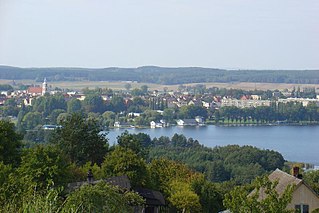
Chodzież is a town in northwestern Poland with 17,976 inhabitants as of December 2021, seat of the Chodzież County in the Greater Poland Voivodeship.

Nakło nad Notecią is a town in northern Poland on the river Noteć with 23,687 inhabitants (2007). It is the seat of Nakło County, and also of Gmina Nakło nad Notecią, situated in the Kuyavian-Pomeranian Voivodeship. It is located in the ethnocultural region of Krajna.

Starachowice is a city in southeastern Poland, with 49,513 inhabitants (31.12.2017). Starachowice is situated in the Świętokrzyskie Voivodeship ; it was formerly in the Kielce Voivodeship (1975–1998). It is the capital of Starachowice County. It is situated upon the River Kamienna, a tributary of the Vistula River, among hills and forests.

Turek is a town in central Poland with 31,282 inhabitants as of 2009. It is the capital of Turek County in the Greater Poland Voivodeship.

Mosina is a town in Poznań County, Greater Poland Voivodeship, Poland, about 20 km south of Poznań, with 12,107 inhabitants (2004). The Mosiński Canal runs east and west through the town, and joins the Warta River just to the east.
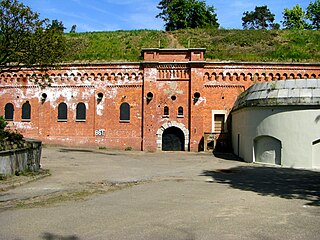
Toruń Fortress is a historic fortress located in Toruń, Poland, one of the largest fortresses in Central and Eastern Europe.
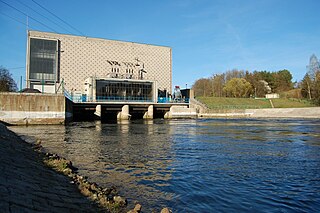
Tryszczyn is a village in the administrative district of Gmina Koronowo, within Bydgoszcz County, Kuyavian-Pomeranian Voivodeship, in north-central Poland. It lies 10 kilometres (6 mi) south of Koronowo and 15 km (9 mi) north-west of Bydgoszcz. It is located in the historic region of Kuyavia.
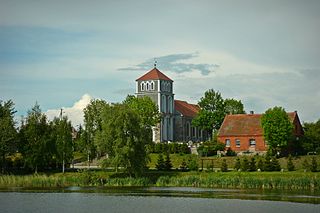
Przysiersk is a village in the administrative district of Gmina Bukowiec, within Świecie County, Kuyavian-Pomeranian Voivodeship, in north-central Poland. It lies approximately 5 kilometres (3 mi) east of Bukowiec, 9 km (6 mi) west of Świecie, 41 km (25 mi) north-east of Bydgoszcz, and 49 km (30 mi) north-west of Toruń.

Łąck is a village in Płock County, Masovian Voivodeship, in central Poland. It is the seat of the gmina called Gmina Łąck. It lies approximately 11 kilometres (7 mi) south-west of Płock and 99 km (62 mi) west of Warsaw. It is located on the western shore of Łąckie Duże Lake.
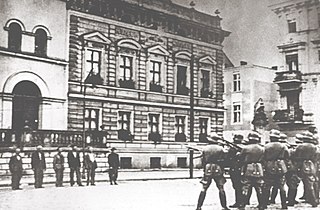
The Intelligenzaktion, or the Intelligentsia mass shootings, was a series of mass murders which was committed against the Polish intelligentsia early in the Second World War (1939–45) by Nazi Germany. The Germans conducted the operations in accordance with their plan to Germanize the western regions of occupied Poland, before their territorial annexation to the German Reich.

Mazovia or Masovia is a historical region in mid-north-eastern Poland. It spans the North European Plain, roughly between Łódź and Białystok, with Warsaw being the unofficial capital and largest city. Throughout the centuries, Mazovia developed a separate sub-culture featuring diverse folk songs, architecture, dress and traditions different from those of other Poles.
The following is a timeline of the history of the city of Poznań, Poland.

Greater Poland, often known by its Polish name Wielkopolska, is a Polish historical region of west-central Poland. Its chief and largest city is Poznań followed by Kalisz, the oldest city in Poland.
The following is a timeline of the history of the city of Lublin, Poland.
The following is a timeline of the history of the city of Płock, Poland.





















